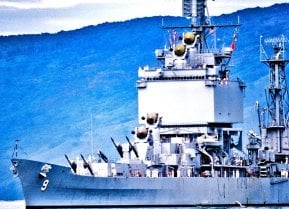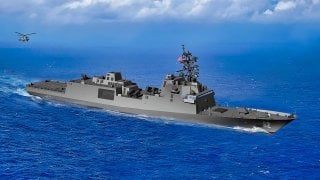The U.S. Navy’s New Constellation-Class Frigate Still Misses the Mark
Specifically, the Navy wanted to replicate the Europeans’ multipurpose frigates (FREMM) in use in the French and Italian navies. In fact, the Constellation-class is being built by an Italian ship manufacturer. The Constellation-class guided-missile frigate was the result of these cogitations by American defense planners.
Summary: The article discusses the U.S. Navy's venture into developing the Constellation-class guided-missile frigate, inspired by European multipurpose frigates, during America's post-Cold War "unipolar moment." Despite strategic triumphs over the Soviet Union, the U.S. turned to its European allies, who were noted for their defense underfunding, for naval innovation. The Constellation-class, built with advanced systems like the Enterprise Air Surveillance Radar and Baseline 10 Aegis Combat System, aims to fulfill multiple naval roles. However, concerns arise over its jack-of-all-trades approach, potential inadequacies in missile launch capabilities, and the challenges it may face against advanced anti-access/area denial (A2/AD) threats from adversaries like China and Iran. The article argues for the necessity of true naval innovation, emphasizing undersea and long-range weapons systems over costly surface combatants, to effectively counter A2/AD challenges.
US Navy's Constellation-Class: A Leap into Future or a Step into Uncertainty?
Plug-and-play was the siren song that so many in the 1990s fell for. This was especially the case of the United States Navy as it came to building the next generations of warships that were intended to dominate the high seas of America’s “unipolar moment.” Inexplicably, after having done the strategic heavy lifting to defeat the Soviet Union in the Cold War, US strategists turned to their European allies for inspiration for the Navy’s next frigate.
Never mind that the Europeans were chronically underfunding their defense or that they essentially expected the Americans to protect them, had war with the Soviets erupted. But America’s defense planners thought the Europeans might have been onto something.
Specifically, the Navy wanted to replicate the Europeans’ multipurpose frigates (FREMM) in use in the French and Italian navies. In fact, the Constellation-class is being built by an Italian ship manufacturer. The Constellation-class guided-missile frigate was the result of these cogitations by American defense planners.
The Specs on the Constellation-Class
The warships will possess an Enterprise Air Surveillance Radar (EASR), Baseline 10 (BL10) Aegis Combat System, and a Mk 41 vertical launch system (the warship has 32 vertical launch system cells). There are an assortment of other systems onboard making it a cutting-edge, unique system in the American fleet. The Constellation-class will have a displacement of 7,291 tons. The Navy has four units under construction.
The Navy wants a total of 2020 in the fleet by the 2030s.
The frigate can be used for multiple mission sets, ranging from anti-surface to anti-submarine warfare to electronic warfare. But the Navy should be careful that its new warship does not become a jack-of-all-trades and master-of-none. This is especially considering the brutal, 20-year failure that was the Zumwalt-class destroyer or the Littoral Combat Ship (LCS).
Point in fact, the new guided-missile frigates are not actually frigates.
As one former Naval officer (who supports the Constellation program) admonished me in a conversation recently: “whatever you want call the Constellation don’t call it a frigate. It’s a mini-destroyer!” He’s right. Because the Constellation-class is far larger than the average frigate is. Oddly, though, the Navy’s new frigate that can do everything for everyone—and that is larger than any known frigate—apparently lacks the requisite number of vertical-launch tubes for missiles.
That’s a big problem, considering it’s a guided-missile frigate.
This became a point of concern among US Navy designers after the Iran-backed, Yemen-based Houthi Rebels decided to run roughshod over the Middle East. Becoming an impediment to international shipping in both the Red Sea and the Strait of Bab El-Mandeb, the US Navy was stymied at first by the severity and unconventionality of the Houthi threat to their warships. Because of this perceived lack of adequate vertical launch capabilities, the four Constellation-class frigates under construction are being delayed until at least 2027.
How Will the Constellation-Class Handle A2/AD?
Given how many drones and anti-ship missiles the Houthis have lobbed at US warships trying to protect international shipping lanes from the Houthis, Navy planners are concerned that their new guided-missile frigate lacks a sufficient number of missile launchers to handle the kind of threats these warships will face.
And if the Houthis are causing dyspepsia among the new frigate’s designers, just imagine what the Chinese or even Russian anti-access/area denial (A2/AD) systems will do to the US Navy’s warships under current conditions.
All this means, though, is that the Constellation-class is going to have to spend more time under construction. At a time when the new warship is greatly needed, especially as the Ticonderoga-class cruisers (the new frigates will fill in some of the roles that the cruisers used to perform) that populate the US fleet are aging out of the service.
Frankly, it is absurd that the Navy did not assume they’d need considerably more firepower to overcome A2/AD-type threats to surface warships than they had put into the Constellation-class. The A2/AD threat is notnew. China’s development of these systems has been dogging the minds of naval war planners for the better part of a decade. Everyone has known that Russia has similar capabilities.
So, too, does Iran (and, therefore, Iranian proxies, like the Houthis and likely Hezbollah).
Then there is the question of: will there ever be enough missiles to protect a US surface warship from the kind of hellfire that America’s autocratic rivals will deploy against them?
The Navy Needs to Truly Innovate, Not Nibble at the Margins
Here again is what is undoubtedly becoming a tired mantra from my work: whatever we can do on the surface, in the age of a complex A2/AD threat, we can surely do better beneath the waves. Further, we can probably do better against A2/AD threats at greater distances, with the advent of hypersonic weapons, as well as via drones—both aerial and underwater unmanned systems. And then, of course, there are lasers.
The Navy really should be all-hands-on-deck, in terms of overcoming the immense A2/AD threats to their surface warships. Lasers, hypersonic weapons, submarines, and drones would all be far more useful in overcoming the A2/AD challenge than any surface combatant that the Navy is blowing vast sums of money on. Instead, we are being treated to yet another costly weapons platform that might not live up to its hype.
Given the Navy’s poor track record thus far with picking new warships for the fleet since the end of the Cold War, I’m inclined to be very skeptical about the promise of the Constellation-class.
About the Author
Brandon J. Weichert, a National Interest national security analyst, is a former Congressional staffer and geopolitical analyst who is a contributor at The Washington Times, as well as at American Greatness and the Asia Times. He is the author of Winning Space: How America Remains a Superpower (Republic Book Publishers), Biohacked: China’s Race to Control Life, and The Shadow War: Iran’s Quest for Supremacy. Weichert can be followed via Twitter @WeTheBrandon.
Image Credit: Creative Commons/U.S. Navy Flickr.


